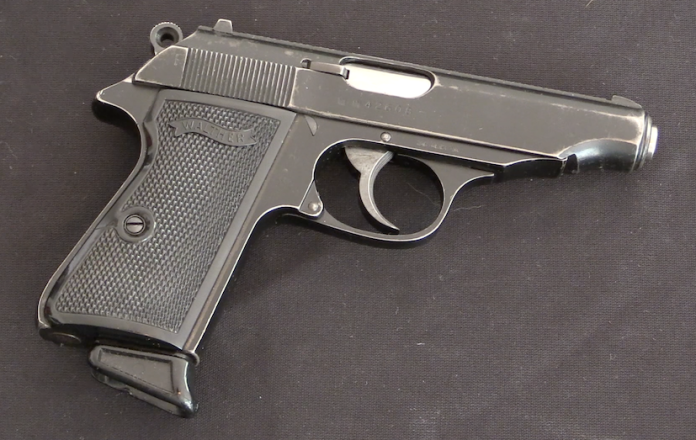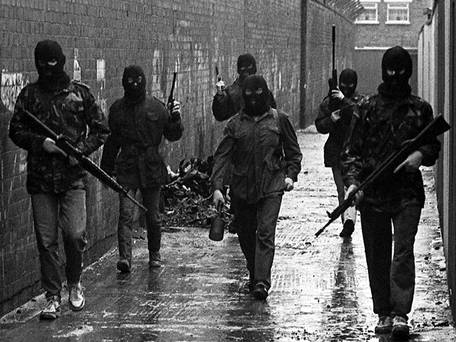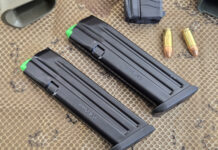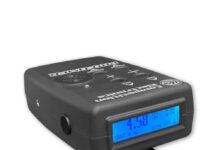
The little .22LR is mostly known for being a plinker’s cartridge. It’s a light recoiling, cheap, and fun round. Perfect for training new shooters and providing cheap fun to more experienced shooters. It’s not common for any serious duty role, but it’s been used more than once by military forces. Today we are talking about one of those rare duty roles where the .22LR served. Specifically, the gun served with the Ulster Defence Force during the Troubles in Ireland. That specific gun is the L66A1.
What’s an L66A1? It’s the official designation given to the .22LR version of the Walther PPk adopted by the British Ministry of Defence. This little gun has an interesting history, and more questions have been asked than answered in regard to its adoption and use. Today we are going to explore what we know, what we’ve heard, and what we can assume.
The L66A1 and the Ulster Defence Force
The Ulster Defence Force was an infantry regiment of the British military that existed from 1970 to 19992. It was a controversial unit that recruited men from Northern Ireland to help police the country during the Troubles. The men recruited often lived in the cities and towns they patrolled and secured. This made them easy targets for the IRA.
In fact, the IRA would identify and target UDR members in their off time. Many were part-time soldiers who had families and daily duties in their communities. The IRA would locate and target the men at work, home, and elsewhere. Kidnappings were common, and a good portion of the casualties of the UDR came from these off-duty attacks.

This led to the requirement to arm the UDR when off duty. The Ministry of Defense placed an order with Walther for 3,000 Walther PPs in .22LR. These became the L66A1 and were issued to the men of the Ulster Defence Force as off-duty personal defense weapons. While .22LR is plenty lethal, it is an odd choice for a personal defense weapon.
We do know that at least once, a UDR member fought off several attackers after being shot seven times in the legs. He killed two and wounded two more. Although the new stories aren’t specific with what gun he used, it is listed as his issued carry gun.
Why the L66A1
Choosing the Walther PP wasn’t a tough choice to make. Walther handguns were rock-solid designs. They were also the compact carry pistol of the day. They were small, thin, and easy to conceal. Easier than the Hi-Power the troops carried daily. Walther firearms were reliable as well, and the blowback action worked for all its problems.
The Walther came in both .32 ACP and .380 ACp as well, which do seem to be a better choice for personal defense. They offer a centerfire cartridge that has fewer reliability issues and would likely penetrate better, especially with thick clothing as a factor.

That leads us to ask, why the .22LR? Sure, it’s light recoiling and easy to handle. I don’t know much about gun culture in North Ireland, but it’s likely a common cartridge. The .22LR can reach deep enough to hit the vitals, but that doesn’t mean it’s the best choice for defensive shooting.
The best guess I can make is if the gun is stolen or captured. It’s just a .22LR. It seems to pose less of a risk to UDR soldiers if captured by the IRA. The rimfire round is certainly less likely to penetrate the soft fragmentation vests worn during this era. However, it is still an odd choice, and eventually, the Brits recognized that.
They replaced these guns with 9mm Walther P5s.
Unofficial Conspiracy Theory
The Troubles were an interesting time for public perception. Two English-speaking European forces were engaged in a muddy knife fight. They both had public relations campaigns, and it wasn’t uncommon for smears and lies to be told to shift public perception. This leads to conspiracy theories.

One included that the Brits gave the UDF .22S for assassinations. They were quieter guns, but even so, it doesn’t hold water to me. A .22LR pistol is quite loud. While it might be quieter than a 9mm, a train is louder than a semi, but you can hear both coming at you a ways away.
The L66A1 was an interesting service pistol for an odd and unusual role. Interarms imported somewhere in the neighborhood of 1,500 L66A1 handguns into the United States, and they pop up on auctions fairly frequently. If you want one, they are out there and quite distinct in their markings.



